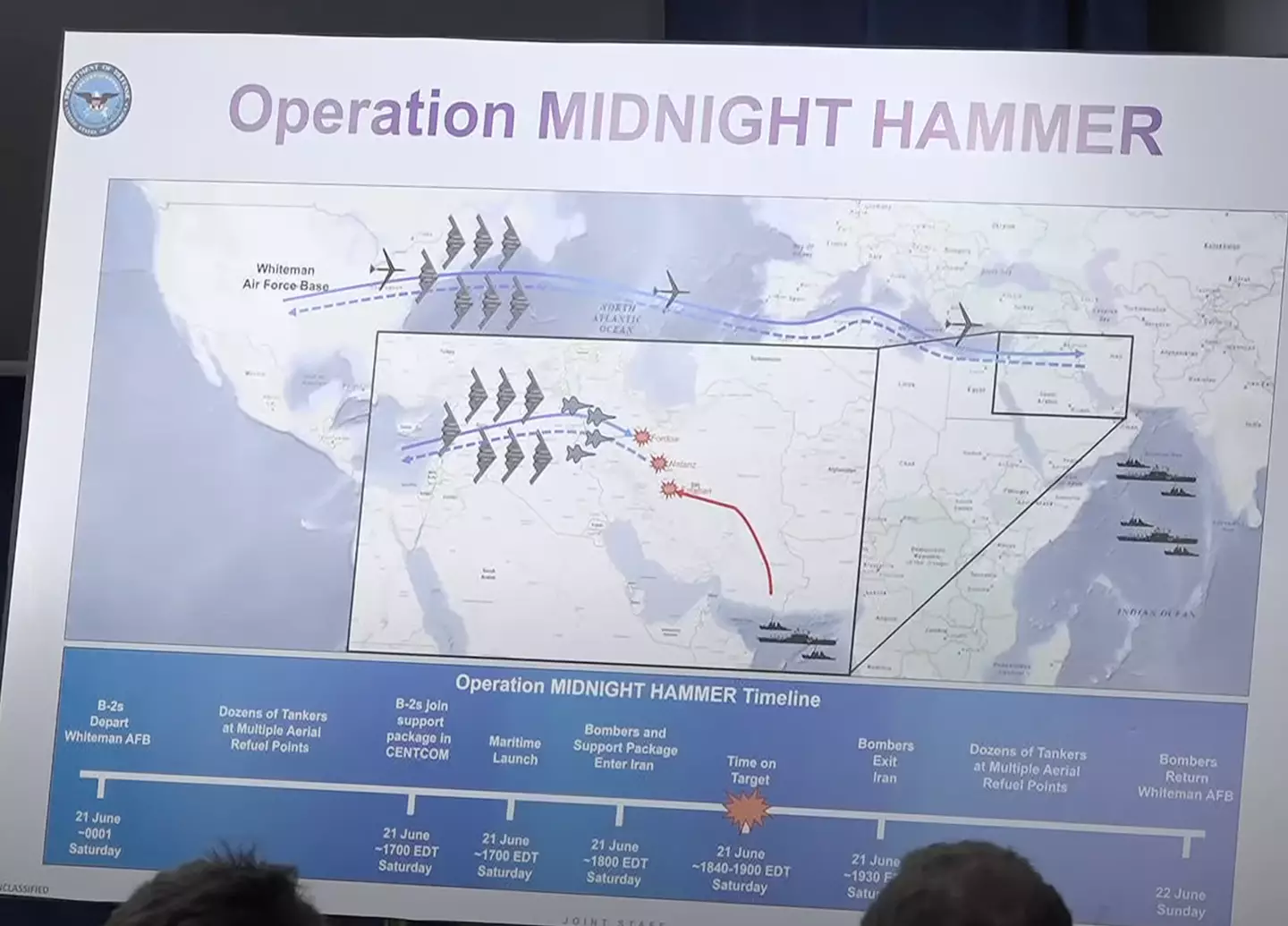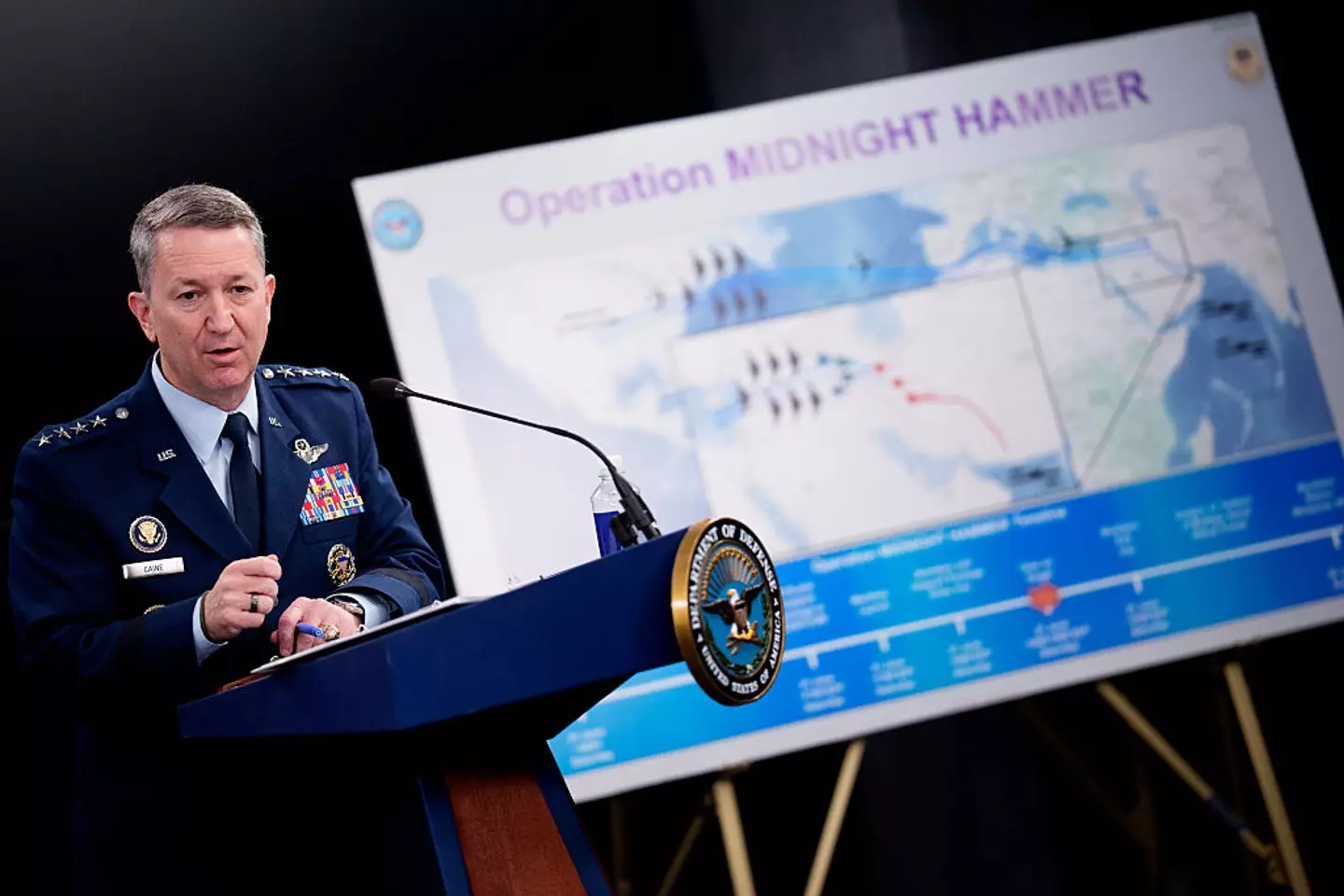The Pentagon has released new information about the covert U.S. military strike on Iran, following President Donald Trump’s confirmation that three of the nation’s nuclear facilities were targeted.
According to the Department of Defense, the coordinated assault—referred to as a “strike package”—was executed at approximately 5:00 p.m. Eastern Time (12:30 a.m. local time), with the final wave of missiles hitting their targets around 7:05 p.m. Eastern (2:35 a.m. local).
President Trump, 79, hailed the operation as a “very successful attack” in a statement on Truth Social and during his national address. He claimed the nuclear sites at Fordow, Natanz, and Esfahan had been “completely and totally obliterated.”
One of the most striking revelations was how U.S. stealth bombers managed to carry out the mission undetected. Military officials highlighted that advanced radar-evading technology allowed the aircraft to reach their targets “without the world knowing,” describing the operation as one of the most sophisticated and secretive in recent years.
Iranian authorities have acknowledged the three facilities were struck but downplayed the damage, insisting the core infrastructure remains intact. In response, Iran’s Foreign Minister Seyed Abbas Araghchi condemned the U.S. attack as “extremely dangerous, lawless, and criminal,” warning that it would carry “everlasting consequences.”
Inside Operation Midnight Hammer
Speaking to reporters in the Pentagon today, Defense Secretary Pete Hegseth has claimed that the US stealth bombers managed to fly undetected as they carried out their mission, which has the codename Operation Midnight Hammer.
“Our B-2s went in and out of these nuclear sites, in and out and back without the world knowing at all – in that way it was historic,” he said.
However, just yesterday dozens of people uploaded footage of these B-2 stealth bombers traveling past them on Twitter.
One person typed: “How is it stealth and invisible if random people see them and post on X?”
“‘Stealth’ meanwhile the whole world knows,” a second added.
Now, chair of the Joint Chiefs of Staff Air Force General Dan Caine has detailed the in-depth attack plan that took place – which included more than 125 aircrafts, some used as a decoy, and 75 precision guided weapons having been fired.
“At midnight, Friday into Saturday morning, a large B-2 strike package comprised of bombers launched from the continental United States,” he explained.

Defense Secretary Pete Hegseth held a press conference following the US airstrikes on Iran (Andrew Harnik/Getty Images)
“As part of a plan to maintain tactical surprise, part of the package proceeded to the west and into the Pacific as a decoy, a deception effort known only to an extremely small number of planners and key leaders here in Washington and in Tampa.”
18-hour mission
It took 18 hours for the B-2 stealth bombers to reach Iran, refuelling multiple times in-flight.
Caine continued: “At approximately 5.00pm, Eastern Standard Time, last night and just prior to the strike package entering Iran, a US submarine in the central command area of responsibility launched more than two dozen tomahawk land attack cruise missiles against key surface infrastructure targets at Esfahan, as the ‘Operation Midnight Hammer’ strike package entered Iranian airspace.
“The US employed several deception tactics, including decoys as the fourth and fifth generation aircraft pushed out in front of the strike package at high altitude and high speed, sweeping in front of the package for enemy fighters and surface to air missile threats.

The strikes were part of the US Department of Defense’s ‘Operation Midnight Hammer’ (Department of Defense)
“As the strike package approached Fordow and Natanz, the US protection package employed high speed suppression weapons to ensure safe passage of the strike package with fighter assets employing preemptive suppressing fires against any potential Iranian Surface to Air threats.”
Bunker buster bombs deployed at Fordow
He went on to explain that the US is not aware of any shots that were fired at its strike package on the way in and out of the country.
“At approximately 6:40pm Eastern Standard Time, 2:10am, Iran time, the lead B-2 dropped two GBU-57 massive ordinance penetrator [GBU-57 MOP – otherwise known as a bunker buster bomb] weapons on the first of several aim points at Fordow,” Caine told reporters.
“As the president stated last night, the remaining bombers then hit their targets as well, with a total of 14 MOPs dropped against two nuclear target areas.

Chair of the Joint Chiefs of Staff Air Force, General Dan Caine, discussed the mission details of the US’ strike on Iran (Andrew Harnik/Getty Images)
“All three Iranian nuclear infrastructure targets were struck between 6:40pm and 7:05pm eastern time again, that’s about 2.10am in the morning local time in Iran, with the tomahawk missiles being the last to strike at Esfahan to ensure we retain the element of surprise throughout the operation.”
Caine added that US forces ’employed approximately 75 precision guided weapons’ during the operation, including 14 GBU-57 MOPs – that weigh a staggering 30,000lbs.
The operation included more than 125 US aircraft, including B-2 stealth bombers, multiple flights of fourth and fifth generation fighters, dozens and dozens of air refueling tankers, a guided missile submarine, and a full array of intelligence surveillance and reconnaissance aircraft, as well as hundreds of maintenance and operational professionals, Caine explained.


